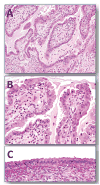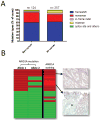Pathogenesis and the role of ARID1A mutation in endometriosis-related ovarian neoplasms
- PMID: 23232571
- PMCID: PMC3523307
- DOI: 10.1097/PAP.0b013e31827bc24d
Pathogenesis and the role of ARID1A mutation in endometriosis-related ovarian neoplasms
Abstract
Endometriosis-related ovarian neoplasms (ERONs) are a unique group of tumors as they are associated with endometriosis, especially endometriosis presenting as an ovarian endometriotic cyst (endometrioma). ERONs include clear cell carcinoma, endometrioid carcinoma, and seromucinous borderline tumor. A growing body of evidence from both clinicopathologic and molecular studies suggests that most, if not all, ERONs develop from endometriotic cyst epithelium through different stages of tumor progression. The endometriotic cyst contains abundant iron-induced reactive oxygen species that are thought to be mutagenic, and chronic exposure of cystic epithelium to this microenvironment facilitates the accumulation of somatic mutations that ultimately result in tumor development. Molecular analyses of ERONs, including genome-wide screens, have identified several molecular genetic alterations that lead to aberrant activation or inactivation of pathways involving ARID1A, PI3K, Wnt, and PP2A. Among all molecular genetic changes identified to date, inactivating mutations of the ARID1A tumor suppressor gene are the most common in ERON. Understanding the molecular changes and pathogenesis involved in the development of ERON is fundamental for future translational studies aimed at designing new diagnostic tests for early detection and identifying critical molecular features for targeted therapeutics.
Conflict of interest statement
None declared.
Figures




Similar articles
-
Loss of ARID1A expression is an early molecular event in tumor progression from ovarian endometriotic cyst to clear cell and endometrioid carcinoma.Int J Gynecol Cancer. 2012 Oct;22(8):1310-5. doi: 10.1097/IGC.0b013e31826b5dcc. Int J Gynecol Cancer. 2012. PMID: 22976498 Free PMC article.
-
Endocervical-type mucinous borderline tumors are related to endometrioid tumors based on mutation and loss of expression of ARID1A.Int J Gynecol Pathol. 2012 Jul;31(4):297-303. doi: 10.1097/PGP.0b013e31823f8482. Int J Gynecol Pathol. 2012. PMID: 22653341 Free PMC article.
-
ARID1A mutations in endometriosis-associated ovarian carcinomas.N Engl J Med. 2010 Oct 14;363(16):1532-43. doi: 10.1056/NEJMoa1008433. Epub 2010 Sep 8. N Engl J Med. 2010. PMID: 20942669 Free PMC article.
-
ARID1A mutations and PI3K/AKT pathway alterations in endometriosis and endometriosis-associated ovarian carcinomas.Int J Mol Sci. 2013 Sep 12;14(9):18824-49. doi: 10.3390/ijms140918824. Int J Mol Sci. 2013. PMID: 24036443 Free PMC article. Review.
-
Seromucinous Tumors of the Ovary. What's in a Name?Int J Gynecol Pathol. 2016 Jan;35(1):78-81. doi: 10.1097/PGP.0000000000000266. Int J Gynecol Pathol. 2016. PMID: 26598986 Free PMC article. Review.
Cited by
-
Diagnostic performance of MR imaging findings and quantitative values in the differentiation of seromucinous borderline tumour from endometriosis-related malignant ovarian tumour.Eur Radiol. 2017 Apr;27(4):1695-1703. doi: 10.1007/s00330-016-4533-x. Epub 2016 Aug 23. Eur Radiol. 2017. PMID: 27553934
-
Circulating miRNAs as Biomarkers for Endometriosis and Endometriosis-Related Ovarian Cancer-An Overview.J Clin Med. 2019 May 23;8(5):735. doi: 10.3390/jcm8050735. J Clin Med. 2019. PMID: 31126056 Free PMC article. Review.
-
Clinical implications of using molecular diagnostics for ovarian cancers.Ann Oncol. 2013 Dec;24 Suppl 10(Suppl 10):x22-26. doi: 10.1093/annonc/mdt464. Ann Oncol. 2013. PMID: 24265398 Free PMC article. Review.
-
Endometriotic cyst fluid induces reactive oxygen species (ROS) in human immortalized epithelial cells derived from ovarian endometrioma.Redox Rep. 2017 Nov;22(6):361-366. doi: 10.1080/13510002.2016.1258448. Epub 2016 Nov 20. Redox Rep. 2017. PMID: 27866464 Free PMC article.
-
Genetic Associations with Gestational Duration and Spontaneous Preterm Birth.N Engl J Med. 2017 Sep 21;377(12):1156-1167. doi: 10.1056/NEJMoa1612665. Epub 2017 Sep 6. N Engl J Med. 2017. PMID: 28877031 Free PMC article.
References
-
- Sampson JA. Endometrial carcinoma of the ovary, arising in endometrial tissue in that organ. Arch Surg. 1925;10:1–72.
-
- Pearce CL, Templeman C, Rossing MA, Lee A, Near AM, Webb PM, Nagle CM, Doherty JA, Cushing-Haugen KL, Wicklund KG, Chang-Claude J, Hein R, Lurie G, Wilkens LR, Carney ME, Goodman MT, Moysich K, Kjaer SK, Hogdall E, Jensen A, Goode EL, Fridley BL, Larson MC, Schildkraut JM, Palmieri RT, Cramer DW, Terry KL, Vitonis AF, Titus LJ, Ziogas A, Brewster W, Anton-Culver H, Gentry-Maharaj A, Ramus SJ, Anderson AR, Brueggmann D, Fasching PA, Gayther SA, Huntsman DG, Menon U, Ness RB, Pike MC, Risch H, Wu AH, Berchuck A. Association between endometriosis and risk of histological subtypes of ovarian cancer: a pooled analysis of case-control studies. Lancet Oncol. 2012;13:385–394. - PMC - PubMed
Publication types
MeSH terms
Substances
Grants and funding
LinkOut - more resources
Full Text Sources
Other Literature Sources
Medical

